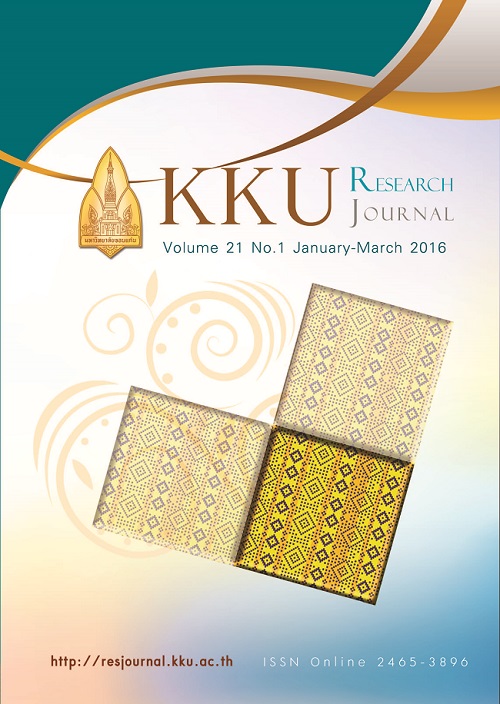Food diversity of three ethnic groups: a case study from Xieng Khuang province, Northern Lao PDR
Main Article Content
Abstract
This qualitative research was carried out using formal key informant group discussions and household semi-structured interview. The objectives of the research were to evaluate food diversity and security of three ethnic groups at Nam Chat village, XiengKhuang province in northern Lao PDR, where the village includes three ethnic groups; Khmu, Hmong and Lao Loum. The study found that rice was the main staple food crop for three ethnic groups. However, Hmong and Khmu representing approximately 30% of total household in this village produced insufficient rice for household consumption. Food was gathered from various kinds of cultivated crops and domestic livestock, and also included wild plants, wildlife aquatic animals and insects. The three ethnic groups consumed different quantities of food sources from crops or animal species, depending on specific ethnic groups. The three ethnic groups earned household income both from crops and domestic animals, as well as from non-timber forest products and wildlife. Lao Loum received per capita income greater than Hmong and Khmu in the present study.
Article Details
References
Production in Northern Lao PDR. 2010. Multiple Cropping Center (MCC), Chiang Mai University
(CMU), Thailand.
[2] Roder W. Slash-and-burn rice systems in the hills of northern Lao PDR: description, challenges, and
opportunities. Int. Rice Res. Inst. 2001. 201p.
[3] N S C . A g r i c u l t u r a l c e n s e n 2010-2011. National Statistic Center, Vientaine, Lao PDR. 2012.
[4] Stuart FOX M. Laos – Politics, economics and society. Frances Pinter, London. 1986.
[5] Phengsavanh P. Forage Legumes as feed for pigs in smallholder production systems in the North of
Lao PDR. Ph.D. Thesis, The Swedish University of Agricultural Sciences, Uppsala. 2013. 65p.
[6] Thongmanivong S. and Fujita Y. Recent land use and livelihood transitions in northern Laos.
M o u n t a i n R e s e a r c h a n d Development. 2006. 26: 237-244.
[7] Krejcie, RV and Morgan DW. Determining sample size for research activities. Educational and
Psychological Measurement.1970.3: 607-610.
[8] Beebe J. Rapid appraisal: The evolutoin of the concept and the definition of issues. Proceeding of
the 1985 International conference on Rapid Rural Appraisal, Khon Kaen University. 1987:47-65.
[9] N S C . A g r i c u l t u r a l c e n s u s 1988-1999. National Statistic C enter, Vientaine, Lao PDR.2000.
[10] Yasuyuki K, Badenoch N, Shinsuke T, Douangsavanh L and Kenichi N. Agency, opportunity and risk:
Climercialization and humannatural relationships in Laos. Southeast Asian Studies.2010.47(4); 365-478.
[11] Keoboualapha B, Simarak S, Jintrawet A, Onpraphai T and Polthanee A.2013. Farmers’s
perception of Imperata cylindrica infestation in a slash-and-burn cultivation area of Nothern Lao
PDR. Southeast Asian Studies. 2013.2(3): 583-598..
[12] NAFRI, NAFES, NUOL. Improving livelihoods in the upland of the Lao PDR, Volume1: Initiatives and
approaches, National Agriculture and Forestry Research Institute, Vientiane, Lao PDR. 2005:264p.
[13] Kent M, Cocker P 1992. Vegetation Description and Analysis: A Practical Approach. London:
Belhaven Press.
[14] Douangsavanh L. Food security of shifting cultivation systems: case studies from Luang prabang and
Oudomxay Province, Lao PDR. Journal of Mountain Science. 2006. 3 (1) : 48-57.
[15] Trading economics. 2015. Laos GDP per capita. Available: https://www.tradingeconimics.com/laos/
gdp-per-capita . A c c e s s e d Jul.29,2015.(16) Millar J, Sengdala B and Stelling A. The role of livestock in changing
upland livelihoods in northern Lao PDR: Facilitating farmer learning according to ethnicity and gender.
Journal of Mekong Societies. 2011.7 (1): 55-76.
[17] Douangsavanh L, Bouahom B and P o u y a v o n g K . E n h a n c i n g sustainable development of diverse
a g r i c u l t u r e i n L a o P D R .UNESCAP-CAPSA Working Paper Series. 2005. 89 : 54p.
[18] Satoshi Y. The trading of a groforest products and comodities in the northern mountainous region of
Laos. Southeast Asian Studies.2010. 47 (4): 374-402.
[19] Satean S, Wattanasap N and P r e m p r a s i t s . C o m m u n i t y utilization of plants in Sirikit Dam.
Jounal of Community Development Research. 2012. 5(1): 74-80.(in Thai with english abstract).

